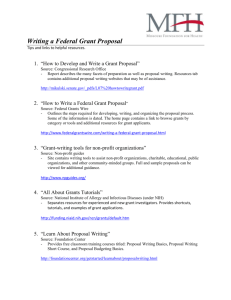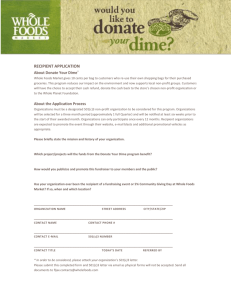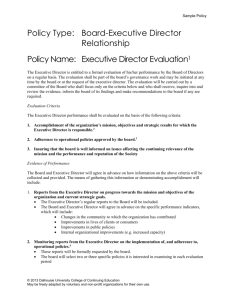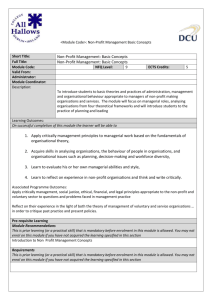Running head - Western Washington University
advertisement
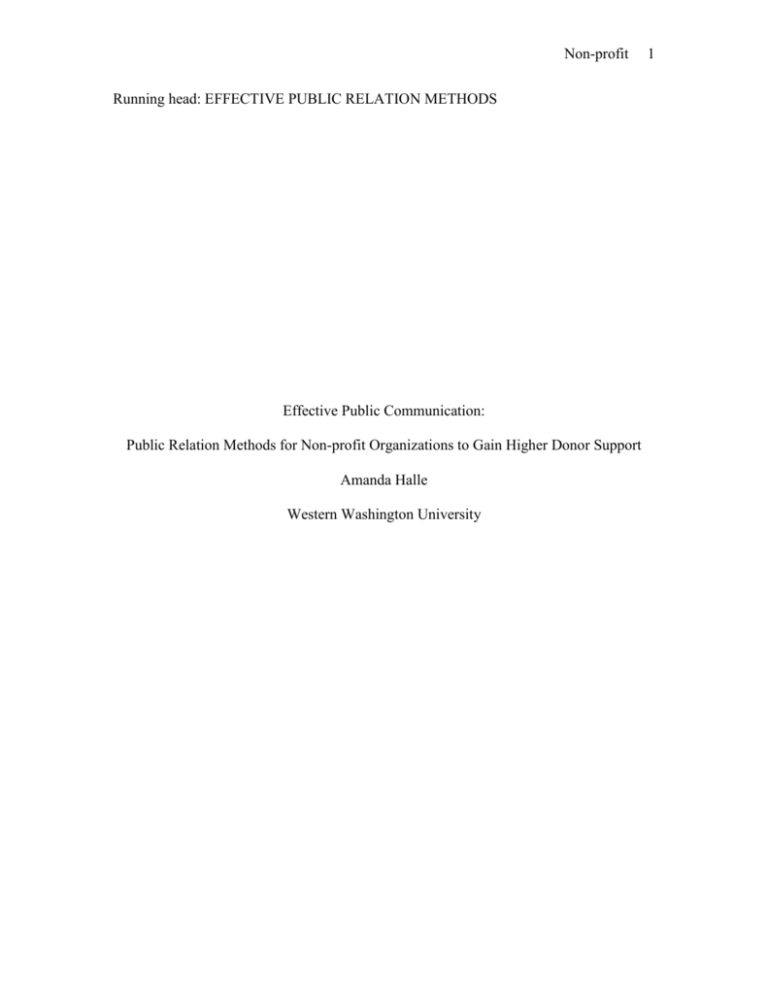
Non-profit Running head: EFFECTIVE PUBLIC RELATION METHODS Effective Public Communication: Public Relation Methods for Non-profit Organizations to Gain Higher Donor Support Amanda Halle Western Washington University 1 Non-profit 2 Introduction Non-profit organizations have been operating mostly on private donations and volunteer or lightly paid staff since the early 1980s, when the Regan government cut a substantial amount of financial support for non-profits (Yeon, Choi, & Kiousis, 2005). Absence of government funding, an increase in the numbers of non-profit communication creating competitiveness, and a lack of individual and household donations has put pressure on non-profits financially (Venable, Rose, Bush, & Gilbert, 2005). Because these organizations and charities are not for profit, they greatly rely on a regular support from private donations. In order to obtain donations and regular revenue, non-profit organizations must have effective ways of reaching the public through advertising and public relations (Waters, 2008). If a non-profit cannot acquire enough funding, the organization will not be able to help the cause they serve. To succeed, a non-profit must know the most effective ways to gain donations from both regular donors and new donors as well as create lasting relationships with donors in order to effectively help their cause (Waters, 2008). Grunig (1993) argued that creating both strong relationships with publics and focusing on symbolic images were important for non-profit organizations. Studies have found that both positive and negatively framed messages are persuasive ways of gaining donor support (Das, Kerkhof, & Kuiper, 2008). Organizations need to know which is message frame is the most influential. Two communication theories are relevant to this topic, the uses and gratification theory and the hypodermic needle theory. In 1979, research was conducted that revealed Non-profit 3 he uses and gratification theory, which assumes that people choose to use areas of media that satisfy their likes and interests (Wood, 2006). How this relates to non-profit organizations is people choose to donate or support a cause that they feel passionate about and may use it to create identity online. (Satchell & Foth, 2008). The hypodermic needle theory, which states mass media’s messages have a direct influence on passive audiences, is now discarded by many mass media researchers (Severin & Tankard, 1992). However, it is still a conceivable theory according to Severin and Tankard and should be considered when measuring message persuasiveness. This relates to non-profits in the measurement of persuasiveness in positive and negative message framing. O’Neil (2006) says non-profit organizations must frame their messages appropriately for their community and audience to be able to gain substantial donor support. The purpose of this study is to examine the ways in which non-profits use public relations and message framing to gain donor support. Advertising, message framing, communication and overall presentation of the organization have an affect on whether a person chooses to donate or not (Das, Kerkhof, & Kuiper, 2008). Some research has been conducted in the area of non-profit organization’s relationship with donors and donor behavior in the area of marketing but less has been done in the area of public relations (O’Neil, 2006) Terms Positive message framing; negative message framing; donor; fundraising; public relations; hypodermic needle theory; uses and gratification theory Literature Review Why People Give Non-profit 4 Despite the popular belief that people give to charity selflessly and without any reluctance (Das, Kerkhof, & Kuiper, 2008), Klandermans (1984) suspects that people choose to give out of expectation of the number of participants involved, the probability of success their contribution will have and the overall probability of success if others also participate. Even if a person feels strongly connected to a non-profit’s cause, they are unlikely to give unless they feel their contribution will effectively help solve the problem (Das, Kerkhof, & Kuiper, 2008) Some people choose to give through the use of cause-related credit cards. Mekonnen, Harris and Laing (2006) conducted research on whether linking credit cards to support for a cause made them more attractive to consumers, for example, a credit card linked with the World Wildlife Fund that donates 25 cents to the group every time you put 100 dollars on your card. What they found was many people were motivated to use the card primarily because of the financial return going back to the cause by using it. However, they also found that most users who stopped using the card did so because the overall relationship between the causal group and the cardholder was weak. Lack of communication between the cause, the card company and the card holder also led to consumer skepticism about how real the financial benefits were to the causal group. Channels for Non-profit Messaging In today’s world, the use of technology is a fast, efficient way to spread messages to large numbers of people. Non-profit organizations use advertising as a primary tool to gain recognition and support for their cause. Research by Sciulli and Bebko (2005) revealed that social cause advertisements, whether they are on television or in print, are different from mainstream, commercial advertisements because they promote some sort Non-profit 5 of behavioral change that will enhance society. In order for the advertisement to clearly promote the presented cause, it must contain some amount of emotional appeal in order to separate itself from an advertisement selling a product (Sciulli & Bebko, 2005). Websites offer non-profit organizations an inexpensive way to reach and interact with donors, volunteers and journalists. Marken (1998) explained the internet as an ideal medium for organization’s because of its high interactive potential which is better for relationship building. Successfully managing a website can boost an organization’s fundraising development as well as volunteer recruitment (Kang & Norton, 2004). Research by Yeon, Choi, and Kiousis (2005) revealed that most non-profit organizations offered the most interactive features on the donor related pages of the website. They concluded that most organizations created web pages that were targeted and mostly informative for donors because donors are held more important than even volunteers and journalists to non-profit organizations. Another very effective way for non-profits to advocate through the internet is through social networking websites such as MySpace, Facebook, YouTube and Flickr (Satchell & Foth, 2008). Satchell and Foth concluded: The digital generation seeks to create, manipulate, control, play, identify themselves, express their taste, their beliefs, political affiliations, their aesthetics, their sexuality and humor via digital representations…creating a digital presence that reveals ‘This is who I am, this is what I believe in’ (p.24) Non-profit organizations can use these insights to help them connect with a younger generation with the purpose of social change and community action. Positive vs. Negative Message Framing Non-profit 6 The way non-profit organization’s messages to the public are framed, positive or negative, could have affect on the message’s success (Das, Kerkhof & Kuiper, 2008). An example of a negatively framed message is, “6 million children die from AIDS every year.” A positive way to say this message would be, “With your support, fewer children will die from AIDS every year.” There are also ways to positively or negatively framed visual images such as pictures or videos. A non-profit could try and motivate people to donate by showing a picture of starving children, looking sad and sick or they could show a picture of children looking happy and healthy because they received donations and now have a better life. Studies have been done to measure the persuasiveness of both positive and negative message framing but reveal that one way is not largely more effective than the other (Das, Kerkhof & Kuiper, 2008). What Das, Kerkhof and Kuiper concluded in their research about message framing was that importance of the charity was better perceived when negative message framing was combined with statistical evidence. For example “A child dies from poverty every four seconds.” But they found a positive frame created better understanding of the organization’s cause when paired with anecdotal evidence. For example, “Since her sponsorship, Jessica has done better in school and has a hope for her future.” A campaign to increase the use of condoms in order to stop the spread of AIDS among adolescent women in Brazil was conducted in 2003. Commercials were played on television, radio and billboards showing the well-known pop singer Kelly Key walking into a pharmacy and without demonstrating any shame, asking for condoms. This message was to show girls, in a positive way, how easy and shameless asking for condoms is. Results of a survey after the release of the commercial revealed that 90% of Non-profit 7 the viewers perceived the advertisement as “excellent” or “good” at conveying the campaigns message (Porto, 2007). Another effective way to be positive through fundraising messages and advertisements is for the organization to convey to the public the likelihood of their goal being reached. This however does not say that by portraying the value of the charity’s goal is a sufficient way to gain support, but it is a very effective way. Despite this fact, in many organizations messages, the focus is on the problem their cause is supporting, rather than the probability of reaching their goal (Das, Kerkhof, & Kuiper, 2008). Research Question Although past research reveals that people better understand a non-profit’s value and importance when it is positively framed with anecdotal evidence or negatively framed with statistical evidence (Das, Kerkhof, & Kuiper, 2008), I would like to propose a new research question. RQ: Which methods in public relations and message framing increase donation income for non-profit organizations? The dependant variable will be the number of donations a non-profit receives over a period of time. The independent variable will be positively or negatively framed messages and evidence.
